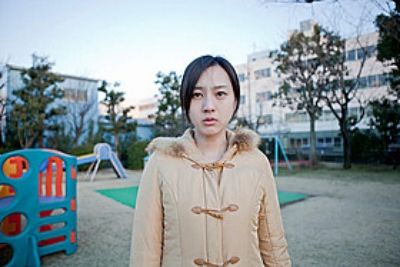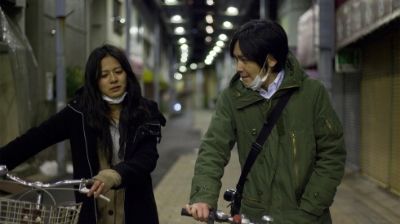
Fiction films dealing with national tragedies are often, for the most part, uplifting affairs. They are made after a sufficient amount of time has passed to put some emotional distance between the film and the subject. There is a tendency to highlight cooperation and acts of banding together to get through the tragedy. It serves a purpose of affirming people’s belief in the triumph of human spirit over enormous adversity: an essential part of the healing process after a great blow to people’s security.
But ODAYAKA, made in reaction to the March 11, 2010 earthquake that hit Japan and the concurrent nuclear panic it brought about, has different intentions (wc) in mind. Ingrained in its story is a deep concern over the ways in which the culture’s emphasis on groups over individuals can, and in this case did, lead a people toward staunch conflict rather than cohesion. Made as the wounds were still being deeply felt by many of Japan’s citizens, Noboteru Uchida‘s film rips the bandage off. An act of cathartic bloodletting instead of a soothing remedy.
The film begins by looking at two couples in the same apartment complex who, despite being next door neighbors, are not acquainted with one another, as they react to the earthquake. Of the utmost concern is the apparent unsettling of a major nuclear reactor in the northern region of Fukushima, and the potentially epidemic fall out from this. In fact, it is the women in each couple who occupy ODAYAKA’s most central roles. As a range of thoughts and emotions overcome them, they both seek out a means of making sense of the situation by turning to online resources.
The act of reaching for outside information, while seemingly logical, here causes ripples of contention. Others view it as standing in opposition to the government’s directives and stirring an unnecessary panic. When the younger mother, played by producer of numerous Asian indie films (including this one) Kiki Sugino, expresses concern over radiation levels in the nursery school her daughter attends, it leads to hostility from other parents and indirect but jarringly vicious attacks from within the community.
The school’s position is one of docile obedience to the establishment. In dialogues that signify the Japanese custom of avoiding direct confrontation, the teachers at the preschool express slight concern, yet an unwillingness to take extra precautions against the threat of radiation poisoning. They refer to the government’s official position as reason for non-action. Whether it is a rational reaction or not, the passivity is maddening to Sugino’s character, whose findings indicate they have every reason to be extremely alarmed.
Meanwhile, the couple next door suffers from not atypical growing pains of domestic partners who have grown familiar with one another. They seem amplified by the earthquake’s devastating effects. The wife’s research into the case of Chernobyl causes her to experience crippling anxiety. Yet hers is a complex reaction. It finds her not only retreating inward, but at other times spreading her concern to those around her. This again rankles people in the community that regard such commotion as an attack on the national unity.
Another theme is how life goes on in spite of tragedy, although in these cases not for the better. Despite it being a time when people most need a respite from life’s stuggles, work and relationship related trials rear their heads as though everything were normal.
Both motifs suggest a kind of denial on a significant scale. Perhaps it is a way of coping with the trauma. Main characters address this situation, uttering a few times ‘nani mo mite inai’; like many expressions in Japanese, its translation is somewhat ambiguous but here it seems to say ‘(it’s as if they) don’t see anything.’
A remarkable aspect of the film is how real all of the interactions feel. Dialogue seems extremely true to life, getting rid of any artifice in order to capture how people really speak. This makes many difficult scenes – the pleading to be reunited with one’s child, the expression of frustration to a loved one that you don’t feel as though you’re a priority – sometimes feel uncomfortably long. But their dramatic effect on the viewer is undeniable.
Despite the emphasis on conflict and mental anguish, there are signs of hope. Being brought together by strenuous circumstances the female protagonists end up invigorating one another in rather unexpected way when their situations are at their bleakest points.
It can perhaps be taken as a statement of bold opposition that strength comes from individual entities: a shared bond between two dissidents, or a single generation couple. Not the company, the local community, the government.
From its title’s (translated into English as ‘calm,’ or ‘serene ‘) deceptive suggestion that conditions are largely stable while in actuality moods are anything but, to its frank cultural criticisms, the film is a quiet storm.
ODAYAKA plays at this year’s Tribeca Film Festival. Visit the festival website for more details.
Stay tuned for an interview with the director and cast coming to these pages soon.
Me on twitter = @mondocurry.
Stay tuned for an interview with the director and cast coming to these pages soon.
Me on twitter = @mondocurry.


No comments:
Post a Comment